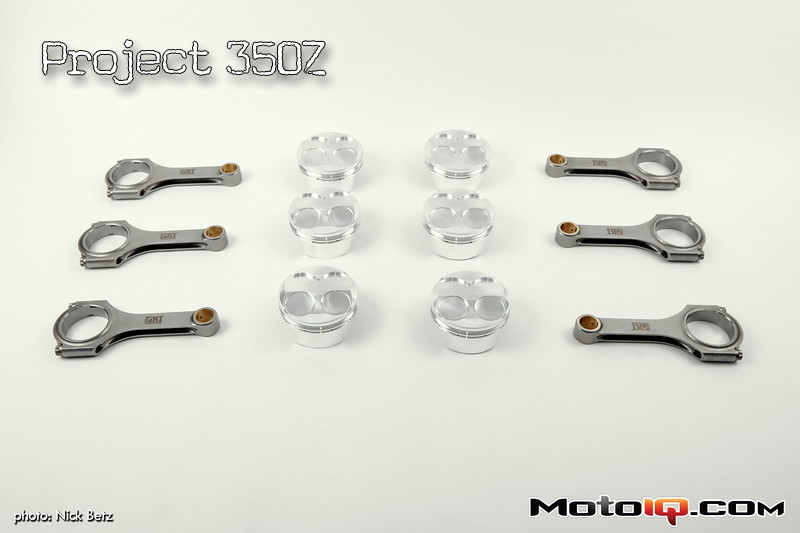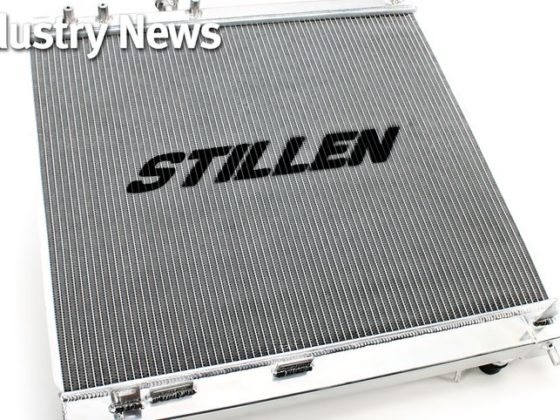,
 We used JE’s off the shelf, standard medium wall thickness straight piston pins. For this sort of engine, we didn’t feel that the additional expense of super light weight taper wall tool steel pins was worth it. We WPC treated the piston pins to prevent galling and to reduce friction.
We used JE’s off the shelf, standard medium wall thickness straight piston pins. For this sort of engine, we didn’t feel that the additional expense of super light weight taper wall tool steel pins was worth it. We WPC treated the piston pins to prevent galling and to reduce friction. The stock VQ35DE oil pump gears are notorious for breaking at much over 7300 rpm in extended use. To get more high rpm durability, we went to the factory later model Rev-Up VQ gears which drop right in. The stock rev limit on the Rev-Up was 7700 rpm. These gears are safe to that with the occasional blast up to 8000 rpm but frequent use at 8000 rpm will also lead to the failure of these gears. To help ensure that our gears will be trouble free we WPC treated them as WPC treatment greatly improves fatigue strengh just like how shotpeening will.
The stock VQ35DE oil pump gears are notorious for breaking at much over 7300 rpm in extended use. To get more high rpm durability, we went to the factory later model Rev-Up VQ gears which drop right in. The stock rev limit on the Rev-Up was 7700 rpm. These gears are safe to that with the occasional blast up to 8000 rpm but frequent use at 8000 rpm will also lead to the failure of these gears. To help ensure that our gears will be trouble free we WPC treated them as WPC treatment greatly improves fatigue strengh just like how shotpeening will. This is the oil pump pressure relief valve. We have blown up a few Nissan engines when this valve sticks wide open when the engine is cold, dumping oil pressure. To reduce the chances of this happening we WPC treated the valve to make it slippery.
This is the oil pump pressure relief valve. We have blown up a few Nissan engines when this valve sticks wide open when the engine is cold, dumping oil pressure. To reduce the chances of this happening we WPC treated the valve to make it slippery. We previously used JWT C2 cams for our engine. C2 cams have 261 degrees of duration and .456″ of lift, requiring upgraded springs and retainers. Since we were upgrading things to rev higher and raising the compression ratio, JWT felt that we could go with the a C8 intake cam while keeping the C2 cam on the exhaust side to give us a bit more top end without loosing bottom end. The C8 cam has 272 degrees of intake duration with .473″ of lift.
We previously used JWT C2 cams for our engine. C2 cams have 261 degrees of duration and .456″ of lift, requiring upgraded springs and retainers. Since we were upgrading things to rev higher and raising the compression ratio, JWT felt that we could go with the a C8 intake cam while keeping the C2 cam on the exhaust side to give us a bit more top end without loosing bottom end. The C8 cam has 272 degrees of intake duration with .473″ of lift. We WPC treated our cams to improve wear and reduce friction.
We WPC treated our cams to improve wear and reduce friction. Since we definitely had to change the engine bearings, We used King XP bearings for the mains. The XP bearing’s pMax-Black material is a tri metal bearing with steel, a very high capacity copper based intermediate layer and a softer lead based overlay that contains 5% copper and undergoes a proprietary hardening process for industry leading load capacity. In addition, the King mains have elliptical oil holes, undercut oil grooves for maximum bearing area, a very tight crush for optimal heat transfer and solid retention and an eccentric ID to help form and maintain a hydrodynamic oil film easier. The bearings are strengthened by a proprietary nano-scaled hardening process that modifies the molecular structure and creates a black fatigue-resistant shield. The outcome is a significant 24% increase in hardness and load capacity, reaching 18.1HV and maximum fatigue resistance of 10,200 psi.
Since we definitely had to change the engine bearings, We used King XP bearings for the mains. The XP bearing’s pMax-Black material is a tri metal bearing with steel, a very high capacity copper based intermediate layer and a softer lead based overlay that contains 5% copper and undergoes a proprietary hardening process for industry leading load capacity. In addition, the King mains have elliptical oil holes, undercut oil grooves for maximum bearing area, a very tight crush for optimal heat transfer and solid retention and an eccentric ID to help form and maintain a hydrodynamic oil film easier. The bearings are strengthened by a proprietary nano-scaled hardening process that modifies the molecular structure and creates a black fatigue-resistant shield. The outcome is a significant 24% increase in hardness and load capacity, reaching 18.1HV and maximum fatigue resistance of 10,200 psi.


